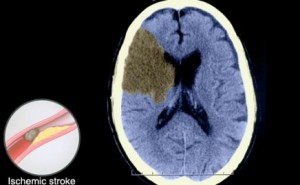Introduction
You can have a better recovery from strokes through early CT scans. This was published in the September 2001 issue of the American Journal of Neuroradiology (Am J Neuroradiol – 01-SEP-2001; 22(8): 1534-42). A group of clinicians from the Foothills Hospital in Calgary/Alberta published an article with a scoring system for CT scans. These scans were done on every patient with a stroke. By utilizing early CT scans and this scoring system an ischemic stroke (due to a blood vessel that closed off in the brain) could be rapidly assessed.
Early CT scan helps to decide whether clot-busting drugs help the patient
Within 3 hours of the beginning of the stroke the treating physician would know whether the patient would benefit from clot-busting drugs (TPA or tissue plasminogen activator) or not. Dr. Pexman and co-workers had noted that patients with an Alberta Stroke Program Early CT Score (ASPECTS) of less than 7 had a poor survival rate or an outcome with high dependency on caregivers. Patients with a score of 7 to 10 had a much better survival chance and were ideal candidates for the clot-busting therapy. The radiologist who reads the CT scan of the brain of the stroke patient divides th CT scan into 10 regions. Researchers evaluate the findings systematically and obtain an ASPECTS score.
Ischemic strokes treated early
Dr. Michael Hill, an assistant professor at the University of Calgary, and one of the co-workers of this initial study has now completed a further follow-up study together with Dr. A.Buchan, director of the Calgary Stroke Program. The authors published the results of the study in the August 2003 issue of the medical journal “Stroke”. They found that ischemic strokes (from clots in the middle cerebral artery) have the best outcome when detected by CT scan early (within 3 hours of the beginning of the stroke) and if thrombolysis therapy with TPA, the clot-busting drug, is done before 6 hours after the beginning of the stroke.
Stroke in the middle cerebral artery diagnosed early
The lack of blood circulation from a stroke, which closed the middle cerebral artery, is shown in this link. What does that mean in practical terms? Let us assume a patient is suddenly losing all of the strength and movement in one arm and losing speech as well. In this case the physician orders an emergency CT scan right away. This helps to determine that the patient had a stroke in the middle cerebral artery region. Let us say that the ASPECTS score was between 7 and 10. This patient’s physicians would likely treat the stroke with the clot-busting medicine mentioned being confident that there likely will be a good outcome.
Less permanent palsies with early intervention
Before this therapy was available, many of these patients ended up with a permanent arm palsy without much function. They likely also sustained a permanent speech deficit as well. After the clot-busting therapy many of these patients have a much better outlook. Now they have a considerably better return of function in their arm and regain their speech as well. Unfortunately, the opposite is true as well.
Those with an ASPECTS score below 7 do poorly with their stroke
Those with a poor ASPECTS score below 7 will not be candidates for the clot-busting therapy. They tend to do poorly. Several countries use this scoring system of early CT scans already to investigate the severity of strokes (ASPECTS). Among those are Canada, the US, Australia and Europe. Dr. A.Buchan said: “Early detection and intervention in stroke is critical to achieve a positive outcome”. He is the director of the Calgary Stroke Program. In addition, he is also a professor in the department of clinical neurosciences of the University of Calgary/Alberta. Here is a link for more background on strokes.






